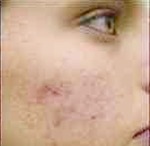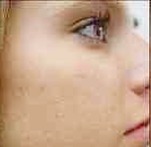When the hair follicles (pores) of the skin get blocked with excess oil and dead skin cells, bacteria grows and the result is the red bumps that we know as pimples or acne. Some types of pimple under skin are more likely to leave scars than others. Squeezing these blemishes can also cause scarring.
If your complexion has been affected by scarring, working out the best pimple scar treatment for you depends on two factors, the severity of the marks and their specific type.
Mild to moderate acne, such as whiteheads, blackheads, papules (red, inflamed blemishes) and pustules (papules with white centers), is common in most people from time to time, and will not normally leave any permanent marks.
 Any red or brown marks that are left on your face are likely to fade over time until they disappear on their own. More severe acne cause nodules (sore, tender, pus-filled cysts under the surface of the skin) which is more likely to leave scarring.
Any red or brown marks that are left on your face are likely to fade over time until they disappear on their own. More severe acne cause nodules (sore, tender, pus-filled cysts under the surface of the skin) which is more likely to leave scarring.
The best way to avoid a permanent reminder of your acne is to seek professional treatment soon after it appears. This will also help to prevent further breakouts, which can lead to more scarring. An experienced dermatologist will examine your nodules and make recommendations for the best pimple scar treatment.
Pimple Scars Treatments, Microdermabrasion and Chemical Peels
 Some popular treatments for mild acne scars include a chemical peel or microdermabrasion. A chemical peel involves applying chemical solutions to the skin to remove damaged outer layers, improving the texture of the skin underneath. After around 10 minutes it is washed off and neutralized. Microdermabrasion is mechanical exfoliation that removes the top layer of dead skin cells and gives the skin a fresh, glowing appearance. Marks left from mild acne can be removed through either of these procedures, which can be carried out in the dermatologist’s office.
Some popular treatments for mild acne scars include a chemical peel or microdermabrasion. A chemical peel involves applying chemical solutions to the skin to remove damaged outer layers, improving the texture of the skin underneath. After around 10 minutes it is washed off and neutralized. Microdermabrasion is mechanical exfoliation that removes the top layer of dead skin cells and gives the skin a fresh, glowing appearance. Marks left from mild acne can be removed through either of these procedures, which can be carried out in the dermatologist’s office.
Resurfacing Treatments Available
[weaver_youtube http://youtu.be/xJAEG0HUpkY percent=100 ratio=0.5625 center=1 rel=0 autoplay=0 https=0 privacy=0 {youtube options}]
Treatment for more severe acne marks include:-
- Laser resurfacing – This procedure involves the use of a carbon dioxide laser which vaporizes the surface skin which has been damaged and reveals the younger skin cells below the surface. These can then develop resulting in the diminished appearance of the scar. Laser resurfacing precisely targets affected areas which makes it particularly effective for this type of treatment as well as for treating hyperpigmentation. It is also used as an anti aging treatment.
- Dermabrasion – This is a much more intensive treatment than microdermabrasion and uses a wire brush or a rough edged diamond wheel. These tools rotate very fast over the skin and actually remove the uppermost layers. The process actually causes injury to the skin and makes it bleed but, as the injury heals, the scar tissue that has been removed is replaced by new skin with a much better appearance.
- Fractional Laser Therapy – This is possibly the safest and most effective way of treating most acne scars. It gets the name “fractional” from the fact that it only works on a tiny area of skin at any one time. It creates tiny holes which pass from the surface of the skin down into the deeper layers below. This process stimulates the production of collagen which creates a smoother skin surface by filling the scars. This laser process leaves the area of skin around each hole undamaged and this results in quicker healing and fewer side effects.
These are more invasive procedures, but are often necessary if the marks are deep or “rolling” scars. The treatments may vary in duration, taking anything from a few minutes up to a couple of hours, depending on the extent of the damage.
Whichever pimple scar treatment method you choose, it is very important to follow your doctor’s guidelines in relation to the healing process to get the very best results possible.